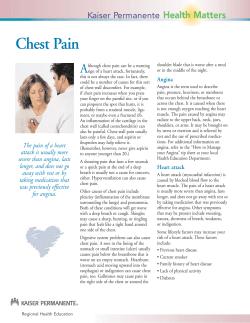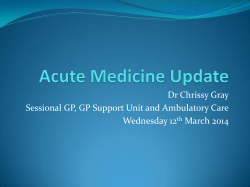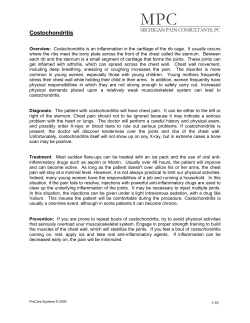
Abstract
Pulmonology Spontaneous Pneumomediastinum: Is a Chest X-Ray Enough? A Single-Center Case Series Yaacov Esayag MD1, Victoria Furer MD1 and Gabriel Izbicki MD1,2 1 Department of Internal Medicine and 2Pulmonary Institute, Shaare Zedek Medical Center and Hebrew University Medical School, Jerusalem, Israel Key words: spontaneous pneumomediastinum, X-ray, pleuritic chest pain, dyspnea, subcutaneous emphysema Abstract Background: Spontaneous pneumomediastinum is a rare entity that usually occurs in young males without any apparent precipitating factor. Several case series have been published focusing on clinical features, workup and prognosis. Due to the rarity of this entity, there is no consensus on the most appropriate treatment. Objectives: To describe the clinical characteristics and course of patients with spontaneous pneumomediastinum in our institution. Methods: This retrospective descriptive study was based on a review of the charts of all patients discharged from our hospital with a diagnosis of SPM during the period 2000 to 2007. Thirteen patients were identified and information on their clinical presentation, course, hospital stay, investigations and outcome was gathered. Results: In 70% of patients the presenting complaint of SPM was pleuritic chest pain, while 30% of patients developed SPM in the course of another respiratory illness. Subcutaneous emphysema was the most common clinical finding (46%). Chest X-ray was diagnostic in 12 of 13 patients, and additional tests such as esophagogram and echocardiogram were unrevealing. Leukocytosis and electrocardiographic changes in inferior leads were seen in 30% of patients. Mean hospital stay was 48 hours, treatment was supportive, and symptomatic improvement was usually noted within 24 hours. No recurrences occurred. Conclusions: SPM is a rare entity that should be considered in patients with pleuritic chest pain. Treatment is supportive, and if no clues for esophageal rupture are present, investigations other than chest X-ray are probably not warranted. It is safe to discharge the patient within 24 hours provided that symptomatic improvement is achieved. IMAJ 2008;10:575–578 Pneumomediastinum is defined as the presence of air within the mediastinum [1]. The incidence varies from 1 in 12,000 to 1 in 30,000 [2], and its association with trauma or esophageal rupture after vomiting is well recognized [3]. In contrast, spontaneous pneumomediastinum is a less recognized, uncommon entity, not associated with an obvious precipitating event and usually has a more benign course. We summarize the clinical presentation, investigations, treatment and prognosis of patients presenting with SPM in our institution and recommend what we found to be the best approach to these patients. Patients and Methods Shaare Zedek Medical Center is a university hospital with 550 beds. The files of all patients admitted to our hospital and discharged with a diagnosis of pneumomediastinum (ICD-9 code • Vol 10 • August-September 2008 518.1) between January 2000 and February 2007 were reviewed, and demographic data, precipitating factors, co-morbidities, presentation, investigations, treatment, hospital course, and outcome were retrieved. Mechanically ventilated patients and those with iatrogenic and trauma-related pneumomediastinum were excluded. Results During this 7 year period 13 patients admitted to our hospital were discharged with a diagnosis of SPM. The incidence was 1 in 41,600 referrals to the emergency room and 1 in 15,500 hospitalizations. Patient characteristics, investigations and hospitalization course are summarized in Tables 1 and 2. The median age of the patients was 19 (range 2–72 years). There were 10 males and 3 females. The main presenting symptom was pleuritic chest pain (9/13) and dyspnea (6/13). Physical examination was normal in six patients, revealing subcutaneous emphysema in six others and tachycardia or tachypnea in the remaining four. Hamman's sign was found in only one patient. Two patients had abnormal physical examination that was attributed to other concurrent illnesses (respiratory tract infection, asthma, interstitial lung disease). Patients were hospitalized in the pediatrics ward, the thoracic surgery ward, the internal medicine ward, the maternity ward, the intensive care unit, and the coronary care unit. The length of hospitalization attributed to SPM varied from 16 to 91 hours (median 48 hours). Precipitating factors were unknown in 54% of patients. The remaining patients had various triggers: asthma exacerbation due to respiratory tract infection in two patients, interstitial lung disease with steroid treatment in one patient, labor 48 hours before presentation in two patients, sport-related in one patient and swallowing of a cracker in one. In three patients SPM developed during hospitalization due to concurrent respiratory illness. Leukocytosis ranging from 11 to 16 x 109 /L was seen in 4 of 10 patients presenting with SPM at admission. Electrocardiogram revealed changes in 4 patients (31%) with T wave inversion and ST elevation of 1 mm in at least two inferior leads. Troponin and serial echocardiogram ruled out myocardial injury. Chest X-ray was diagnostic in all except one patient (see Figure 1 for a typical chest X-ray of SPM). In three patients there was also radiological evidence of pneumothorax. Most patients SPM = spontaneus pneumomediastinum Spontaneous Pneumomediastinum 575 Pulmonology Table 1. Characteristics, clinical presentation and course of patients with spontaneous pneumomediastinum Patient Age # Gender (yrs) Length of hospitalization (days) * Ward Symptoms Signs Precipitating factors 1 F 72 Internal medicine Dyspnea s.c.e Unknown ILD with new steroid Tx ** 2 M 14 Pediatrics Pleuritic chest pain, dyspnea Tachypnea, s.c.e Unknown Concurrent pneumothorax 2–3 3 F 21 Internal medicine Pleuritic chest pain, dyspnea None Labor None <1 4 M 27 ICU Dyspnea None New-onset Asthma attack, asthma attack RTI, steroid Tx ** 5 M 11 Pediatrics Chest pain None radiating to neck Unknown None 1–2 6 M 15 Pediatrics Dyspnea, chest pain radiating to neck Tachypnea, Hamman’s sign, s.c.e. Sport activities Pulmonary blebs, 2–3 concurrent pneumothorax 7 M 19 Thoracic surgery Pleuritic chest pain, dysphagia None Swallowed a cracker Pulmonary blebs > 3 8 M 17 Thoracic surgery Pleuritic chest pain s.c.e Unknown Recurrent pneumothorax 2–3 9 M 24 Thoracic surgery Pleuritic chest pain, neck pain Tachypnea Unknown None >3 10 M 2 Pediatrics Dyspnea s.c.e Unknown Pneumonia, asthma 2–3 11 M 16 CCU Pleuritic chest pain None Unknown None 2–3 12 F 20 Maternity Pleuritic chest pain Tachycardia, Labor s.c.e None >3 13 M 19 Internal medicine Epigastric pain None None 1 Unknown Co-morbidities * Hospitalization length attributed to SPM **In this case hospitalization length was not attributed to SPM. ILD = interstitial lung disease, Tx = treatment, s.c.e = subcutaneous emphysema, RTI = respiratory tract infection, CCU = coronary care unit, ICU = intensive care unit underwent additional imaging tests; in six patients more than two sets of chest X-ray were performed, chest computed tomography was done in seven, and echocardiogram in two patients. An esophagogram was done in 3 of 13 patients and excluded esophageal lesions. In two patients the length of hospital stay was dictated by their condition on admission and SPM did not influence the decision to discharge. In patients 10 and 12 the development of SPM prolonged their hospital stay by 24 and 48 hours respectively; thus, the SPM-related hospitalization stay was less than 48 hours in 6 of 11 patients. All patients received supportive treatment and five necessitated oxygen supplementation. By discharge, symptoms had resolved in all patients although 12 patients still had radiological evidence of SPM. Patients were followed by thoracic surgeons, primary care physicians and pulmonologists. Radiological resolution was seen within 3 weeks after discharge in seven patients; three patients did not undergo further imaging but reported no recurrence in the long-term follow-up (2–5 years), and two patients were lost to follow-up. Only one patient (# 8) presented with recurrent pneumothorax and underwent blebectomy 4 months after discharge. None of the patients presented recurrence of pneumomediastinum by the time of the review. Table 2. Number of investigations performed Patient # 576 Chest X-ray Chest CT 1 2 1 2 2 3 1 1 4 2 2 5 1 1 6 4 1 7 4 1 8 3 9 3 10 2 Esopha gography Echocar diography 1 1 1 1 1 11 3 1 12 3 1 13 2 Y. Esayag et al. 1 Figure 1. Chest X-ray of a patient with SPM • Vol 10 • August-September 2008 Pulmonology Discussion The first to describe SPM was Laennec in the 19th century [1] and the first case series was published by Hamman in 1939 [4]. Typically, SPM presents in a young adult male with pleuritic chest pain and sometimes dyspnea. We report here our experience of 13 patients with diagnosis of SPM over a 7 year period. Chest pain, usually pleuritic, radiating to the neck or back, was the most common presenting symptom, as previously reported [1,3,5,6]. The vital signs and general appearance of patients were normal in most of them, reflecting the benign course of the disease. The most encountered physical finding was subcutaneous emphysema in 46%; the frequency in other series ranges from 40% to 66% [3,6,7]. Although well described, the pathognomonic Hamman's sign was encountered in only one of our patients, while in other series it was present in 19–40% of patients [3,6-8]. The incidence of SPM is variable, depending on the series. A recent study reported 1 in 30,000 admissions [3], while in our series the incidence of SPM in adult patients reached 1 in 41,000 referrals to the emergency department and 1 in 15,000 hospitalizations. Considering the low incidence of this entity, the number of patients reported in our single-center experience is considerable. It is possible that this entity is under-diagnosed since a high index of suspicion is needed to make the appropriate diagnosis even after performing a chest X-ray, as suggested by Yellin et al. [8] who found that performing a routine chest X-ray in young patients presenting to the emergency room with chest pain increased physicians' awareness and improved the detection of SPM. The greater availability of CT scans in emergency rooms could probably aid in the diagnosis of SPM in patients with otherwise unexplained chest pain or dyspnea. It is also possible that cases of SPM developing in hospital are under-diagnosed if there is no subcutaneous emphysema and chest X-rays are not ordered, especially if the patients’ condition is stable or improving. The pathophysiology of SPM appears to be the rupture of alveoli secondary to increased pressure or over-distension and dissection of gases through the lung into the hilium [2]. SPM has been associated with Valsalva maneuvers [8], barotraumas [9] and asthma [3,7,8]. In our series two patients had bronchospasm that was suspected to be a new-onset asthma attack, but none of our patients had a history of asthma. Another associated condition reported in the literature is history of drug abuse such as cocaine sniffing [10]. In our series no drug abuse history was elicited. Patient # 1 presented with a worsening dyspnea of 2 months duration, and chest CT revealed features of interstitial lung disease. The patient was admitted to our hospital and treated with intravenous pulse of methylprednisolone, and a week after hospitalization she developed SPM. This presentation is atypical, but the development of pneumomediastinum without any obvious precipitating event fits the definition of SPM. Only one similar case of interstitial lung disease and steroid treatment as possible causes of SPM was reported previously [3]. In two patients SPM developed after labor. The patients devel- • Vol 10 • August-September 2008 oped symptoms only 48 hours after labor and not immediately as usually reported [11,12]. It is important to note that leukocytosis was present in 40% of the patients with SPM without any concurrent illness, a finding not previously reported. This is important since these patients underwent more investigations and had a prolonged hospital stay due to the search for esophageal rupture or mediastinitis, although the clinical picture was benign. Another unique aspect of our series not reported previously was the presence of ECG changes, especially in inferior leads, in up to 30% of patients. We speculate that air can irritate the pericardium and account for ECG changes, but the inferior leads predilection is not clear. These changes were overlooked on admission in three patients, probably because of the low pretest probability for cardiac disease in these patients. In one of the patients the ECG changes were so pronounced that he was admitted to the Cardiac Care Unit until the correct diagnosis was made and myocarditis, ischemia and pericardial illnesses were ruled out. SPM can be considered to account for ECG changes when no myopericardial pathology is suspected. Chest X-ray was not diagnostic on admission in two cases: one was diagnosed after the radiologist's review and the other was diagnosed only by CT scan. In a study by Kaneki et al. [13], 30% of mild pneumomediastinum cases were not detected by chest X-ray and CT scan of lungs was more sensitive in these cases. As in our series, no benefit was added by the performance of CT scan. Chest X-ray was the only study performed in two patients in our series. In most patients several radiographs, CT scan and esophagograms were performed. These studies expose young patients to significant amounts of radiation in a relatively short time. According to our experience, if there is no history of traumatic event, vomiting or swallowing before the symptoms develop, chest X-ray should be sufficient to diagnose SPM, and if the patient is in good clinical condition no further tests are needed. If SPM is suggested by clinical evaluation and chest X-ray is not diagnostic, a CT scan should be performed. Only if esophageal rupture is suspected, based on clinical grounds, should a contrast-enhanced swallow, CT scan and endoscopy be considered [14]. We believe that with greater awareness of this entity by emergency department staff, a directed search for even mild pneumomediastinum in postero-anterior and lateral views, in cases of unclear chest pain, will succeed in diagnosing the vast majority of cases, obviating the need for further investigations. The need for further evaluation including serial X-rays should be dictated by the clinical findings only. The course of this entity is usually self-limiting and the only therapy needed is bed rest, avoiding Valsalva maneuvers, analgesics and probably oxygen in order to increase the reabsortion rate of the air in the mediastinum. This series supports a short stay in the hospital, probably 24 hours, to observe the patient for deterioration or unsuspected ruptured viscus. Jougon and colleagues [15] reported that after their published experience, the management of their patients changed from an invasive Spontaneous Pneumomediastinum 577 Pulmonology investigative approach to a simple approach consisting of a short in-hospital observation period and a chest X-ray as the only diagnostic imaging. In conclusion, SPM is a rare entity that is probably under estimated by physicians and should be considered in any patient with unexplained pleuritic pain. If chest radiograph is diagnostic no further investigations are needed in a typical patient. These patients benefit from a short admission for observation. Symptomatic relief typically occurs within 24 hours but radiological resolution can be expected within 3 weeks. References 1. Bodey GP. Medical mediastinal emphysema. Ann Intern Med 1961;54:46–56. 2. Maunder RJ, Pierson DJ, Hudson LD. Subcutaneous and media stinal emphysema: pathophysiology, diagnosis and management. Arch Intern Med 1984;144:1447–53. 3. Newcomb AE, Clarke CP. Spontaneous pneumomediastinum: a benign curiosity or a significant problem? Chest 2005;128: 3298–302. 4. Hamman L. Spontaneous mediastinal emphysema. Bull Johns Hopkins Hosp 1939;64:1–21. 5. Abolnik I, Lossos IS, Breuer R. Spontaneous pneumomediastinum: a report of 25 cases. Chest 1991;100:93–5. 6. Gerazounis M, Athanassiadi K, Kalantzi N, et al. Spontaneous pneumomediastinum: a rare benign entity. J Thorac Cardiovasc Surg 2003;126:774–6. 7. Chapdelaine J, Beaunoyer M, Daigneault P, et al. Spontaneous pneumomediastinum: are we overinvestigating? J Pediatr Surg 2004;39:681–4. 8. Yellin A, Gapani-Gapanavicius M, Lieberman Y. Spontaneous pneumomediastinum: is it a rare cause of chest pain? Thorax 1983;38:383–5. 9. Mumford AD, Ashkan K, Elborn S. Clinically significant pulmonary barotraumas after inflation of party balloons. BMJ 1996;313: 1619. 10. Barbara-Mir JAB, Vallejo-Galvete J, Velo-Plaza M, et al. Spontaneous pneumomediatinum after cocaine inhalation. Respiration 1986;50:230–2. 11. Sutherland FW, Ho SY, Campanella C. Pneumomediastinum during spontaneous vaginal delivery. Ann Thorac Surg 2002;73:314–15. 12. Nieboer B, Aboosy N, Verschoor L, Huisman A. Pneumomedia stinum as a cause of acute chest pain postpartum. J Matern Fetal Neonatal Med 2006;19:243–5. 13. Kaneki T, Kubo K, Kawashima A, et al. Spontaneous pneumomediastinum in 33 patients: yield of chest computed tomography for the diagnosis of the mild type. Respiration 2000;67:408–11. 14. Friedman T, Papiashvili M, Eviatar E, Bar I. Atypical pneumomediastinum or “occult” esophageal perforation. IMAJ 2004;6:372–3. 15. Jougon JB, Ballester M, Delcambre F, et al. Assessment of spontaneous pneumomediastinum: experience with 12 patients. Ann Thorac Surg 2003;75:1711–14. Correspondence: Dr. Y. Esayag, Dept. of Internal Medicine, Shaare Zedek Medical Center, P.O. Box 3235, Jerusalem 91031, Israel. Phone: (972-2) 652-9506 Fax: (972-2) 666-6971 email: dyjesa@bezeqint.net It's not the genius who is 100 years ahead of his time but average man who is 100 years behind it Robert Musil (1880-1942), Austrian novelist, whose unfinished long novel The Man Without Qualities is generally considered one of the most important modernist novels. God made everything out of nothing, but the nothingness shows through Paul Valery (1871-1945), French poet, essayist and philosopher Capsule Regulation of NFκ-b activity has significant influence on persistent infection Many of the key immune pathways initiated in response to infection begin with the activation of the transcription factor NFκ-b. Thus, it would not be unreasonable to expect that at least some pathogens would have evolved the means by which to impede this pathway. Kravchenko and team demonstrate that the opportunistic bacteria Pseudomonas aeruginosa produces a small signaling protein, 578 Y. Esayag et al. C12, which impairs the turnover of proteins critical to the regulation of NFκ-b activity. The resulting reduction in transcription of key immune response genes could have significant influence on persistent infection by this and other bacteria. Science 2008;321:259 Eitan Israeli • Vol 10 • August-September 2008
© Copyright 2025













